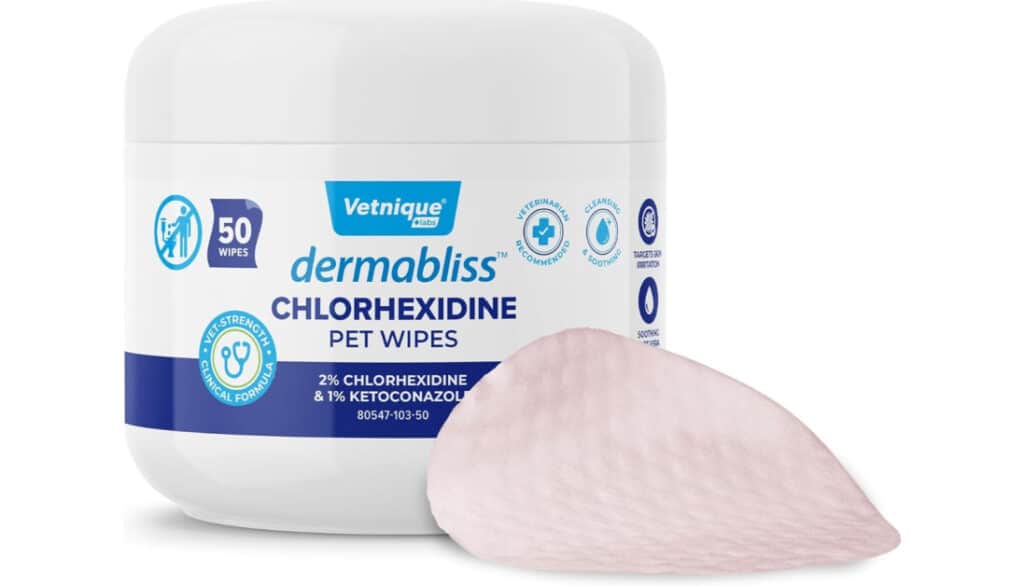Hello, I’m Dr. Candy Akers. As a veterinarian with years of experience caring for our furry friends, I’ve encountered countless questions from concerned pet owners about the best ways to maintain their pet’s health and hygiene. One topic that frequently comes up is the use of chlorhexidine wipes for dogs. With the plethora of pet care products available in the market, it’s essential to understand which ones are truly beneficial and safe for our beloved companions.
In this blog, I aim to shed light on chlorhexidine wipes, their benefits, and how to use them effectively. Drawing from my professional experience and observations, I’ll also rank some of the top vet-recommended brands. Let’s dive into the world of pet care and ensure our dogs receive the best possible attention they deserve.
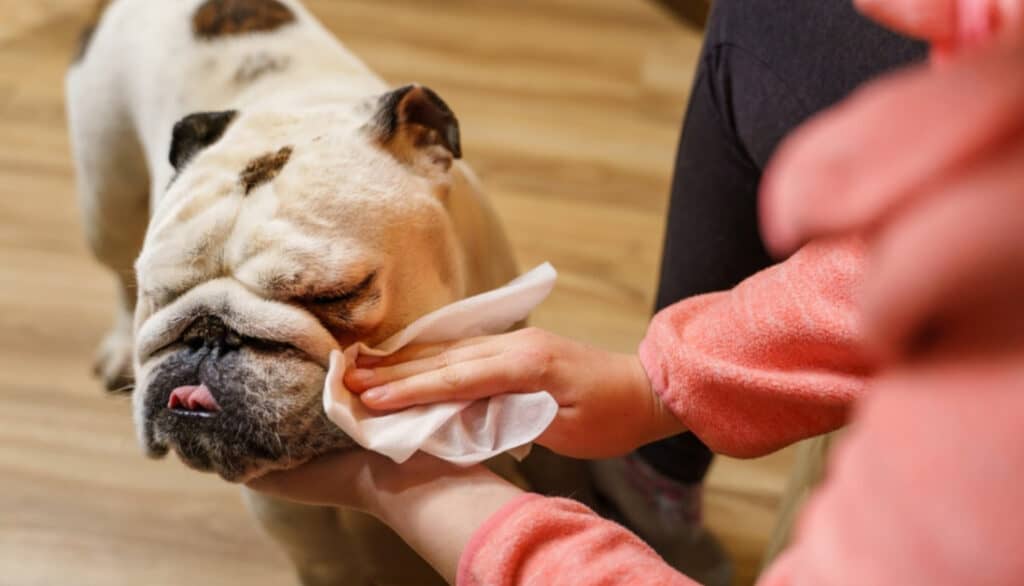
What Are Chlorhexidine Wipes?
Antiseptic towelettes infused with chlorhexidine gluconate, a potent antiseptic agent, actively combat a wide range of bacteria, including both Gram-positive and Gram-negative strains, as well as some fungi and viruses, making them widely recognized in the medical and veterinary fields.
These wipes are designed for topical use, meaning they are applied directly to the skin. In the context of our canine companions, chlorhexidine wipes serve multiple purposes:
- Infection Prevention: They can be used to disinfect minor cuts, scrapes, or abrasions, helping to prevent potential infections.
- Skin Conditions: For dogs with certain skin conditions, such as bacterial or fungal overgrowths, these wipes can help reduce the microbial load on the skin’s surface, alleviating symptoms and preventing flare-ups.
- Hygiene Maintenance: Just as we humans might use an antiseptic wipe on our hands or face, chlorhexidine wipes can be used to clean a dog’s paws, face, or other areas that might get dirty during the day. This is especially useful for dogs that are prone to skin infections or have sensitive skin.
- Post-Surgical Care: After surgical procedures, especially those involving the skin, chlorhexidine wipes can be used to keep the area clean and free from harmful microbes, reducing the risk of post-operative infections.
It’s essential to understand that while chlorhexidine is a potent antiseptic, it’s also generally safe for topical use on dogs. However, like any product, it’s crucial to use it correctly and be aware of any potential side effects or reactions.
Benefits of Using Chlorhexidine Wipes for Dogs
I’ve seen firsthand the advantages of incorporating chlorhexidine wipes into a dog’s care routine. These antiseptic towelettes offer a range of benefits, making them a valuable tool for pet owners. Here are some of the primary benefits of using chlorhexidine wipes for dogs:
- Effective Antiseptic Properties: At the heart of chlorhexidine wipes is the antiseptic agent chlorhexidine gluconate. Its broad-spectrum antimicrobial activity ensures that a wide variety of pathogens, including bacteria, fungi, and some viruses, are effectively neutralized upon contact.
- Convenience and Ease of Use: Unlike liquid antiseptics or creams, chlorhexidine wipes are easy to use. They’re pre-moistened, ensuring consistent application and can be used on-the-go.
- Prevention of Skin Infections: Regular use of these wipes, especially on dogs prone to skin issues, can help reduce the risk of bacterial and fungal infections. By keeping the skin’s microbial population in check, we can often prevent minor issues from escalating into more severe infections.
- Supports Healing: For dogs with existing skin conditions or wounds, chlorhexidine wipes can aid the healing process. By ensuring the affected area remains clean and free from harmful microbes, the body’s natural healing mechanisms can work more effectively.
- Reduces Odor: Many pet owners notice a reduction in the ‘doggy smell’ after using chlorhexidine wipes. This is because the wipes help control the bacteria that can contribute to unpleasant odors.
- Safe for Sensitive Areas: Chlorhexidine wipes are gentle enough to be used on a dog’s face, paws, and other sensitive areas. This makes them ideal for cleaning areas that are often hard to reach or wash with traditional methods.
Incorporating chlorhexidine wipes into your dog’s care routine can be a game-changer. Especially for those with skin sensitivities or those living in environments where they’re exposed to dirt and potential pathogens regularly.

Top Vet-Recommended Chlorhexidine Wipes for Dogs
Dr. Candy’s Reccommendations:
Most of these products also include a topical antifungal medication in them in addition to chlorhexidine. In my clinical experience most skin conditions that benefit from chlorhexidine wipes, also benefit from the included antifungal medication. Infections may be caused by superficial bacteria and yeast on your dog’s skin. The antifungal medication helps to clear the yeasty overgrowth even faster.
Nootie Medicated Dog Wipes, 2% Chlorhexidine and 2% Miconazole Formulated Pet Wipes
PROs:
- Strong Medication Concentration: The Nootie Medicated Dog Wipes are formulated with 2% Chlorhexidine and 2% Miconazole, which are effective in treating symptoms of ringworm, hotspots, allergy dermatitis, and ear and skin infections.
- Large Wipe Size: These wipes are 5″ x 6” in size, ideal for use on larger areas like belly or multiple skin folds. They also come in a pack of 70, providing a good quantity of wipes.
- Easy to use and efficient: They have successfully helped in treating skin irritations and itchiness of pets, demonstrating efficacy. This is one of the strongest medications available OTC.
CONs:
- Strong Smell: Some users believe the smell of the wipes is quite strong. While not necessarily unpleasant, it smells as if there is an added fragrance which some people might find unnecessary or even bothersome.
- Small Residue: The smaller version of this product can also leave a sticky residue on hands after use.
Great For: Stubborn fungal infections, ringworm, stinky or crusty skin folds.
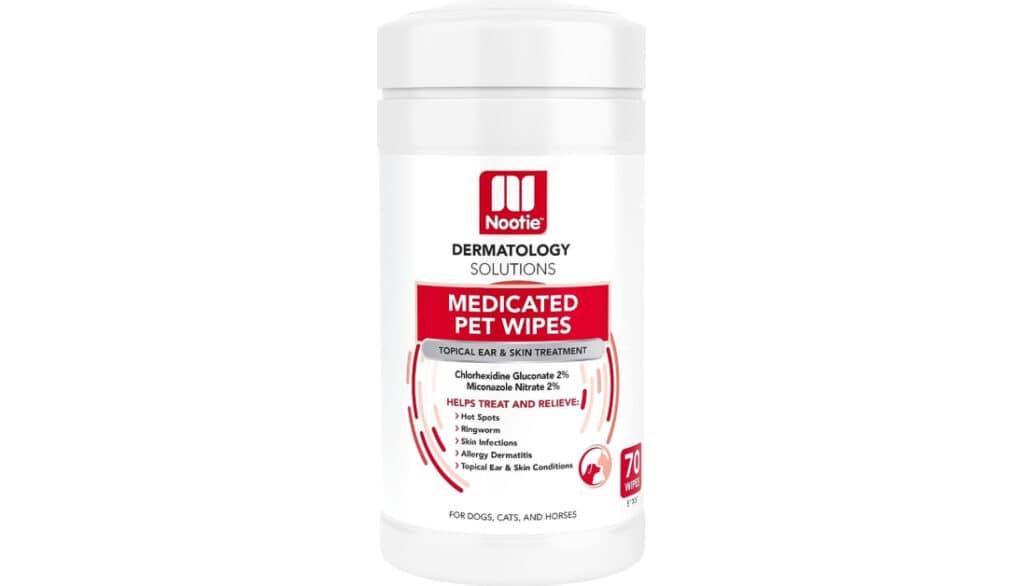
Pet MD XL Topical Wipes with Aloe for Dogs (70ct)
Pros:
- Effective: The Chlorhexidine Gluconate Medicated Dog Wipes are designed to effectively treat a range of skin conditions, including allergies, and hot spots, potentially providing considerable relief for your pet.
- Two Medications: The inclusion of active ingredients like Chlorhexidine and Ketoconazole offers a dual benefit of cleaning and medicated treatment, which could provide comprehensive skincare for your pets.
- Soothing Aloe: The addition of Aloe Vera in the formulation helps soothe discomfort and replenish dry skin, enhancing the overall health and fragrance of your pet’s skin.
Cons:
- Not As Specific: For pets with complicated or severe skin conditions, the results of using Chlorhexidine Gluconate Medicated Dog Wipes could differ, making it potentially less ideal as a sole treatment option.
- Packaging: The larger wipe dispenser has a tendency to dry out faster than screw lid jars.
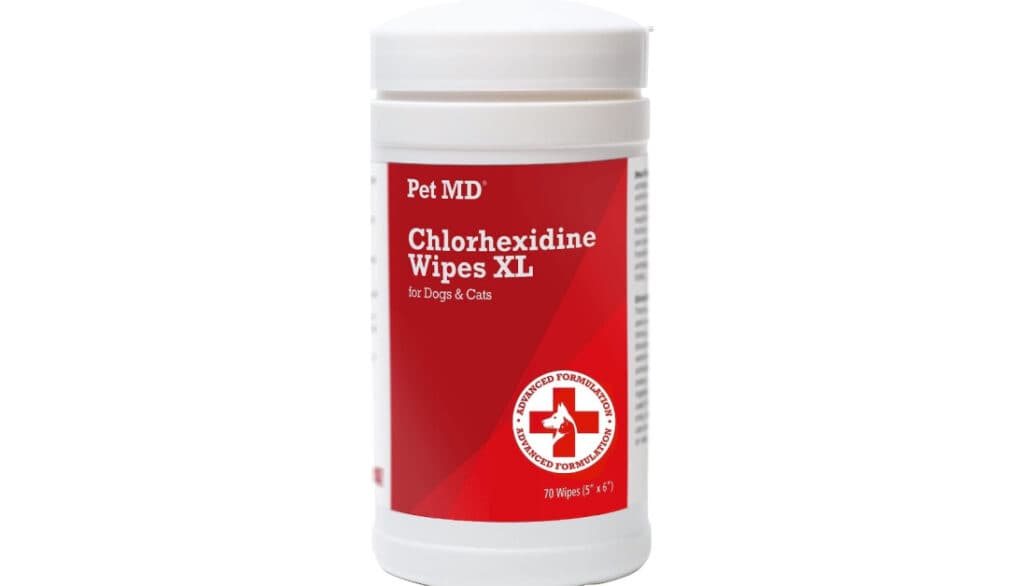
Dechra MiconaHex + Triz Wipes For Dogs (50ct)
Pros:
- Super Convenient: MiconaHex+Triz Wipes are convenient as they are designed for quick and easy use, offering a practical solution for maintaining coat and skin health on a daily basis.
- Multi-modal Antiseptic: The active ingredients in the wipes—2% miconazole nitrate, 2% chlorhexidine gluconate, and USP tris-EDTA—offer beneficial properties such as antifungal, antibacterial, and barrier repair, contributing to the overall health and hygiene of the animal.
- Residual Effects: Chlorhexidine exhibits residual effects, allowing the medication to remain on the skin and offer prolonged protection. The product is designed for universal application, making it useful for all areas and skin conditions without requiring a prescription.
Cons:
- Sensitive Skin: Due to their use of specific active ingredients, MiconaHex+Triz Wipes may not be suitable for all dogs, particularly those with skin sensitivities or those allergic to components like miconazole nitrate or chlorhexidine gluconate.
- Small Quantity Per Jar: The pack size offering is limited to 50 wipes, which may mean frequent repurchasing for owners of multiple dogs or for those dealing with severe or persistent skin conditions.
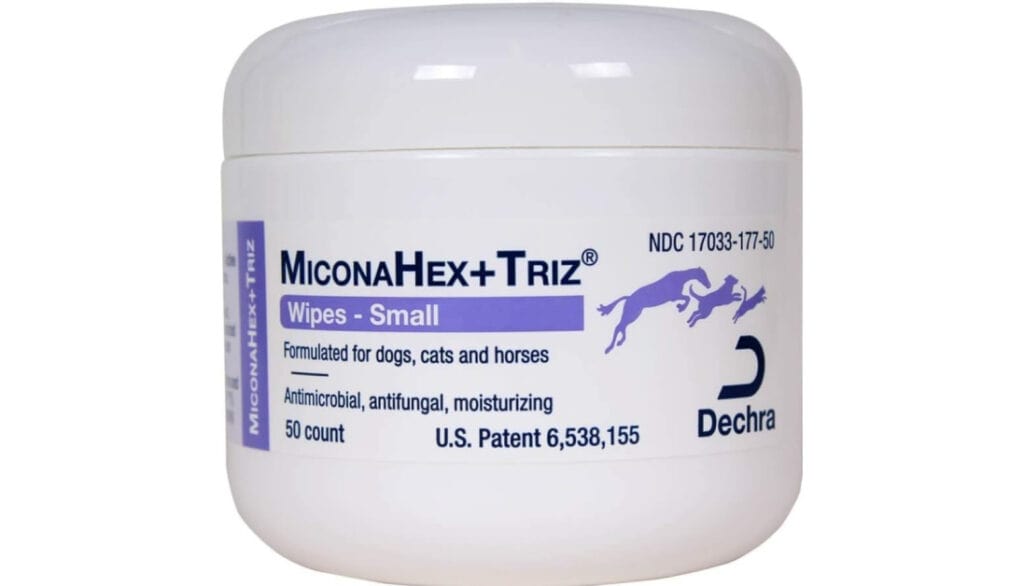
Vetnique Labs Dermabliss Dog – Ditch The Itch Medicated Relief, 50ct Skin Wipes
Pros:
- Veterinary Strength Formula: The wipes contain 2% Chlorhexidine, a disinfectant that helps decrease bacteria on the skin, and 1% Ketoconazole, an antifungal ingredient. This combination makes the wipes effective in treating skin infections like ringworm and seborrhea.
- Easy and Convenient: The design of the small wipes enables on-the-go use, making them convenient for both in-home and outdoor situations. They have a specific formulation for pets, enabling quick and easy cleaning.
- Soothing Relief with Aloe: The wipes contain Aloe Vera Leaf Juice, which provides soothing relief for itching and irritated skin. This can be especially beneficial for pets with allergies or skin sensitivities.
Cons:
- Some customers reported that the product leaves a residue after application, which may be unpleasant for some pet owners and their animals.
Great For: Irritated skin, mild infections
Smiling Paws Pets – Antibacterial & Antifungal Wipes for Dogs & Cats (with Chlorhexidine & Ketoconazole)
PROs:
- Effective Treatment: The Smiling Paws Pets Medicated Antibacterial & Antifungal Wipes are formulated with active ingredients, such as Ketoconazole and Chlorhexidine, that help treat and eliminate various skin infections in dogs and cats, including yeast infections, fungus, bacteria, mange, ringworm, hotspots, and pyoderma.
- Perfect Size: These wipes are designed to be wet, small (2.5″x2.5″), and thin enough to fit into every crevice, such as paws, without causing discomfort to your pet. They are ideal for hot spot treatment for dogs’ paws and for treating bacterial, fungal, and yeast infections.
- Soothing and Satisfying: In addition to their effective active ingredients, these wipes also contain soothing Aloe and Essential Fatty Acids, which help soothe infected areas and provide relief to your pet. They are great for hot spot treatment, mange treatment, pyoderma, ringworm, and other skin infections.
CONs:
- Small Quantity: The package contains a limited number of wipes, which may not be enough for long-term or repeated use, especially if you have multiple pets or if your pet requires ongoing treatment.
- Scent: Some customers have reported that the scent of these wipes is not very pleasant, which may be a drawback for those who are sensitive to strong odors or who prefer scent-free products.
Great For: Hot Spots, Superficial Infections, crusty hairloss along edge of ear
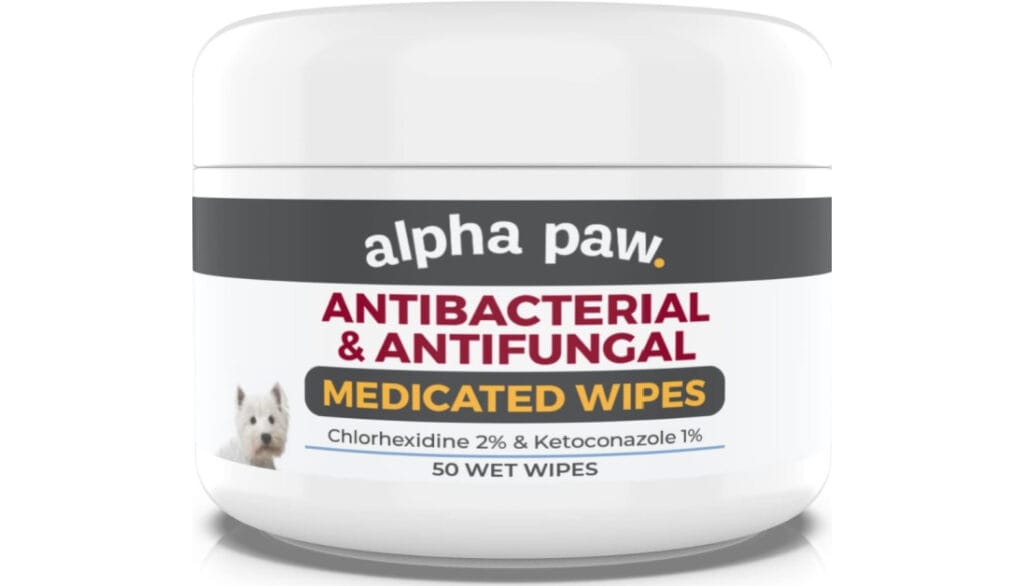
How to Properly Use Chlorhexidine Wipes on Dogs
Using chlorhexidine wipes on your dog is a straightforward process, but there are some best practices to ensure maximum effectiveness and safety. Here’s a step-by-step guide on how to use these antiseptic towelettes correctly:
- Choose the Right Product: Not all chlorhexidine wipes are created equal. Ensure you’re using a product specifically designed for dogs, as some human-grade wipes might contain additional ingredients that aren’t safe for pets.
- Clean the Area First: If your dog has visible dirt or debris on their skin, gently clean the area with water and a mild dog shampoo. This will allow the chlorhexidine to come into direct contact with the skin.
- Gently Wipe the Area: Open the packaging and unfold the wipe. Gently but thoroughly wipe the area of concern, ensuring the skin is moistened with the solution. For areas like the paws, ensure you get between the toes. If cleaning the face, be careful around the eyes, nose, and mouth.
- Let it Air Dry: After wiping, allow the area to air dry. Chlorhexidine works best when left on the skin, so there’s no need to rinse it off.
- Monitor for Reactions: While adverse reactions are rare, it’s essential to monitor your dog after using the wipe. If you notice any redness, swelling, itching, or discomfort, discontinue use and consult your veterinarian.
- Frequency of Use: Depending on your dog’s needs and your vet’s recommendations, you might use the wipes daily, several times a week, or only as needed. For instance, dogs with recurrent skin infections might benefit from more frequent use, while others might only need occasional cleaning.
Using chlorhexidine wipes is a simple yet effective way to maintain your dog’s skin health.
Potential Side Effects and Precautions
While chlorhexidine wipes are generally safe and well-tolerated by most dogs, as with any product, there’s a potential for side effects or adverse reactions. Being informed about these possibilities and taking necessary precautions can help ensure your dog’s safety and well-being. Here’s what you need to know:
Potential Side Effects:
- Skin Irritation: Some dogs might experience mild skin irritation after using the wipes. This can manifest as redness, itching, or slight swelling in the area where the wipe was applied.
- Allergic Reactions: Though rare, some dogs might be allergic to chlorhexidine or other ingredients in the wipe. Symptoms of an allergic reaction can include hives, severe itching, swelling, difficulty breathing, or gastrointestinal upset.
- Dryness or Flaking: Prolonged use of chlorhexidine wipes can sometimes lead to dryness or flaking of the skin, especially in dogs with already dry or sensitive skin.
- Discoloration: In very rare cases, repeated use of chlorhexidine on light-colored fur might cause slight discoloration. This is purely cosmetic and doesn’t indicate harm.
Precautions:
- Patch Test: Before using the wipes all over your dog, consider doing a patch test on a small area of skin. Monitor for any adverse reactions for 24 hours. If no reaction occurs, it’s likely safe to use the wipes as directed.
- Avoid Sensitive Areas: While the wipes can be used on the face, be cautious around the eyes, nose, and mouth. If the solution gets into the eyes, rinse thoroughly with water and consult your veterinarian.
- Do Not Ingest: Ensure your dog doesn’t ingest any residue from the wipes. While chlorhexidine is safe for topical use, ingestion in large amounts can be harmful.
- Consult a Veterinarian: If your dog has an existing skin condition or if you’re unsure about using the wipes, always consult with your veterinarian first. They can provide guidance tailored to your dog’s specific needs.
- Monitor After Use: Always observe your dog after using the wipes. If you notice any signs of discomfort, discontinue use and seek veterinary advice.
- Store Out of Reach: Ensure the wipes are stored out of reach of pets and children. The packaging can be a choking hazard, and ingestion of the wipes can be harmful.
While chlorhexidine wipes offer numerous benefits for maintaining your dog’s skin health, it’s essential to use them responsibly and be aware of potential side effects. By taking the necessary precautions and staying informed, you can provide the best care for your furry companion.

Conclusion
Navigating the world of pet care can often feel overwhelming with the myriad of products available, each promising optimal health and well-being for our beloved companions. Chlorhexidine wipes, as we’ve explored, stand out as a versatile and effective tool in maintaining our dogs’ skin health. Their antiseptic properties, combined with the convenience of use, make them a valuable addition to any pet owner’s toolkit. However, as with all things, knowledge is power.
As a veterinarian, my primary goal is to ensure the health and happiness of our furry friends. I hope this guide has provided clarity and confidence in using chlorhexidine wipes for your dog. Remember, always prioritize your pet’s comfort, monitor their reactions, and when in doubt, consult with a professional. Here’s to many more happy, healthy days with our four-legged family members!
Frequently Asked Questions
A: Yes, chlorhexidine wipes are generally safe for all dogs when used as directed. However, individual dogs may have sensitivities or allergies, so it’s always a good idea to do a patch test first and monitor for any adverse reactions.
A: Chlorhexidine wipes can be used on puppies, but it’s essential to be extra gentle and avoid sensitive areas like the eyes and mouth. If your puppy has a specific skin condition or concern, consult with your veterinarian before use.
A: The frequency of use depends on your dog’s needs. For general cleaning and maintenance, using the wipes a few times a week is sufficient. However, for dogs with skin conditions or post-surgical care, daily use might be recommended. Always follow your vet’s advice.
A: While chlorhexidine wipes are generally safe, some dogs might experience skin irritation, dryness, or allergic reactions. It’s crucial to monitor your dog after each use and discontinue if you notice any adverse effects.
A: While chlorhexidine wipes are meant for external use only, a small accidental ingestion might not be harmful. However, if you notice any signs of distress, vomiting, or unusual behavior, contact your veterinarian immediately.

